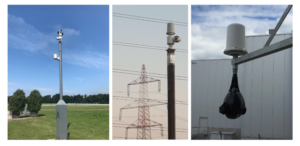This paper describes the fundamental technological differences between the Scan-360 radar and thermal imaging systems (both fixed and rotary). Compared to Scan-360, thermal imaging has limited measurement capabilities and therefore fewer ways to mitigate false alarms.

Performance in Adverse Weather
Fog, rain, and high humidity can severely limit the range of thermal imaging systems due to scattering of light off droplets of water. The higher the density of droplets, the more the infrared (thermal) signal is diminished. Depending upon the humidity, ambient temperature, and the scene content, thermal systems may or may not perform well.
Scan-360 detection range is not affected by fog, rain, humidity, ambient temperature or the target proximity to any heat source.
Target masking
Thermal imaging relies on heat measurements, therefore intruders can be masked by walking near to walls or stone structures that retain heat, or sources of heat, such as vehicles, generators, air conditioning or exhaust vents, furnaces, etc. Intruders may quickly and easily mask themselves by placing a blanket over their body to reduce thermal emissions.
Scan-360 uses microwave radio signals that “see through” fabrics and does not rely on temperature measurements for target detection. Scan-360 will easily detect an intruder wearing thick clothing, covered in a blanket, wrapped in heat blocking foil sheet, or close to any heat source.
Unlike a thermal camera, the Scan-360 actively illuminates the search area with an invisible microwave signal, so can readily detect any masked target.

Direct Measurement of Target Range
Thermal imaging systems only measure temperature, not distance to the object being measured and can therefore suffer from false alarms.
Thermal cameras cannot scale target size based on distance, so very small, but very close objects (such as insects or birds) can give a similar reading to a distant larger object such as a human.
Scan-360 accurately discriminates between small/close and big/distant targets. Rotating thermal cameras can cover up to 360°, but these suffer from the same fundamental inability to measure range.
Some systems attempt to estimate range based on mathematical assumptions, but not direct measurements of range. These assumptions are often incorrect in complex natural environments, for example nearby swarms of insects or birds will be very difficult to distinguish from distant intruders.
Because Scan-360 directly measures range it automatically de-sensitises certain locations to reduce the false alarm rate. For example if a tree is blowing in the wind, only the immediate vicinity of the tree is made less sensitive, not the whole area.
Thermal cameras can only analyse blocks of pixels that do not necessarily correlate to any particular topographical area. For example a swarm of insects close to the thermal camera will cause responses over many pixels that will reduce detection probability at all subsequent ranges. Scan-360 simply ignores insect or bird swarms as it accurately measures the object’s range, size, bearing and velocity, giving superb situational awareness and low false alarm rate.
Summary
| Scan-360 target detection probability is high, even in challenging weather conditions where thermal cameras may struggle. |
| Scan-360 can detect intruders regardless of the ambient temperature/humidity, or how much heat the intruder emits or tries to mask. |
| Scan-360 directly measures four key target parameters: bearing, range, speed and amplitude. Rotary thermal cameras can only directly measure bearing and amplitude so have less situational awareness to mitigate false alarms. |
| Scan-360 is an active system (like a searchlight), detecting targets in any environmental conditions. Thermal imaging is a passive technique that is completely reliant on target and environmental conditions to operate effectively. |